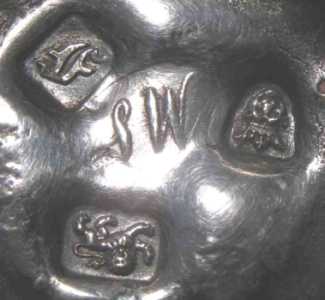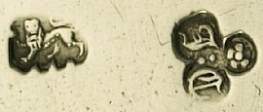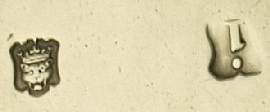(click on photos to enlarge image)
APPRENTICESHIP AND FREEDOM FOR THE ENGLISH GOLDSMITH
A subject not dealt with, except in passing, in most books
on the subject of antique silver plate is apprenticeship and
freedom and the student is left to make what he or she can out
of the available information. For this reason a few words about
the requirement laid upon all English goldsmiths before they
could have any hallmarks applied to their plate would seem
appropriate.
One of the earliest marks to be struck on English silver,
introduced by statute in 1363
(see note 1) was the maker’s mark and to be able to
use such a mark it was usual for a maker to have completed an
apprenticeship in the craft of the silversmith. I think it
appropriate therefore to say something about apprenticeship and
what leads from it. The only other marks required by law were
the assay marks (hallmarks) and to have these struck on his
plate the maker had to be ‘free’ of one of the Guild Companies.
I start therefore with ‘freedom’ and how it was obtained.
Whenever one reads anything written about specific silversmiths,
either in the form of a treatise on a silversmith's life or
merely the reference to him in Grimwade
(see note 2) the word
FREEDOM always crops up. "He was made free" or "he gained his
freedom" are typical references. A student of the subject soon
becomes aware that freedom must have more than one meaning and,
indeed, could easily be led into the belief that there were
three distinct freedoms, and a young man wishing to train and
then set up shop and trade as a silversmith had to ‘gain’ all
three.
In fact there were two distinct freedoms which were so closely
interlinked with each other that they are difficult to separate
and thus lead to confusion, a confusion exacerbated by the fact
that one of these freedoms is itself comprised of two freedoms
which are synonymous. When an apprentice had "served his term"
and his "binding" to his master was thus broken, he was free of
that master. This freedom was synonymous with freedom of the
Livery Company at which his apprenticeship had been registered,
that is he became a Freeman of that company, but not with
freedom of the City of London which had to be gained quite
separately.
It seems that apprenticeship was originally a rather informal
affair in which a master craftsman would take on a boy to work
with him, probably as a means of obtaining cheap labour. That
the boy would inevitably learn the trade his master practised
occurred almost incidentally, notwithstanding that this was the
accepted way of passing on the trade skills from one generation
to the next, and it was commonly ten years before he was
declared competent to ply that trade on his own.
In 1400 this term was reduced to seven years when the
arrangement was formalised and a boy would be 'bound' to a
master as an apprentice under a formal contract. The papers,
known as indentures, relating to this contract, called 'the
binding', were kept at a Livery Company Hall and at the binding
the master had to pay a fee to the Livery Company of twenty
shillings.
Since 1531 apprenticeship has been governed by statute and under
this law the amount payable by the master was reduced to 2/6
(12½p). He also had to undertake to provide the apprentice with
housing, clothing and food (see
note 3). The apprentice, for his part, undertook not to
take on any sort of debt during his apprenticeship and not to
get married. It was usual for his family to pay the Master
Craftsman a fee at the binding but there was no fixed sum
involved and figures ranging from less than £20 to more than
£30, and even up to £80, can be found in the records. As the
rules governing this contract were amended from 1835 onwards
what follows is confined to conditions before that date.
Although under the 1531 law governing apprenticeship the term of
the binding was seven years (the term of a modern apprenticeship
is four years) it could be varied; Arthur Manwaring was bound to
William Tyler in 1635 and served eight years before gaining his
freedom, Thomas Ash (bound in 1675) and William Lutwich (bound
in 1683) also had the term of eight years written into their
indentures. According to the records Jacques Desrumeaux was
bound to Peter Harache II in 1703 and did not gain his freedom
until 1715 but this would have been most unusual
(see note 4)!
Freedom from the Goldsmiths' Company could be gained by a person
in one of several ways. Servitude; that is having served his
time as an apprentice and satisfied his master that he had
sufficiently learned his trade that his contract could be
broken, Patrimony; that is gaining freedom because his father
was a freeman before his birth (the applicant had to be a
natural child born in legal wedlock), Redemption; that is paying
a fine (fee). These freedoms could not be gained before the age
of 21 years.
There were also honorary freedoms, which do not concern us here,
and freedom by courtesy which will be dealt with later. Freedom
by servitude and freedom by patrimony were both a right and not
a privilege.
Freedom from the city was gained in the same way and being free
of the city not only meant that a man could trade within the
city limits but it conferred on him other privileges such as
exemption from the military press and exemption from market fees
anywhere in the country. Aliens (foreigners) had always been
denied freedom and this was formalised by an act of common
council of 1574 (see note 5).
Freedom by servitude was achieved when the apprentice had
finished his time, "learning by doing". He would present his
"masterpiece", a piece made without supervision, to 'Hall' and
if accepted his contract of apprenticeship was broken and he was
made free of his master by 'service'. Sometimes freedom would be
granted on the authority of the master without the presentation
of a masterpiece.
Being free of his master meant that he was, on payment of a fine
(fee) of two shillings (10p), a Freeman of the Company and was
qualified to ply his trade and take on apprentices of his own.
He had to show however that he had learned to read and write,
and to swear an oath of obedience to the wardens. It was
customary for the master to provide him with two suits of
clothes on being made free
(see note 6) and I have come across entries in the Court
of Assistant's minute books at Goldsmiths' Hall which read
"Freedom and Clothing" as if the Goldsmiths' Company provided
these suits of clothes but as this was not the case the entry
shows how closely freedom of the Company and freedom from the
master were linked.
There were two levels of membership of a Livery Company such as
the Goldsmiths'; Freeman and Livery. A Freeman of a livery
company could apply for the freedom of the City but only when
free of both the Company and the City could he become a
Liveryman and although as a Freeman of the City he could stand
for election as a Common Councilman, Alderman (including Lord
Mayor) or Sheriff of the City, he could not become a member of
his company’s Court of Assistants until he had been chosen to
become a Liveryman (see note
7). The Court of Assistants is the governing body of a
Livery Company and was originally an informal body useful for
consultation by the Wardens but grew to be embodied in the
ordinances and is now an essential part of the company. "The
earliest record of Assistants seems to exist in the Grocers'
annals for 1379 where it is enacted that; ‘at the first
congregation of Wardens there shall be chosen six of the Company
to be helping and counselling the same Wardens' "
(see note 8).
A man who did not gain the freedom of the City and was therefore
a “non Freeman” but was free of a livery company and thus
qualified to ply his trade could do so as a ‘journeyman’
provided he was licensed by the corporation. Often he would
continue to work for his old master in the capacity of
journeyman but he could, if he wished, go to another workshop
and sometimes a silversmith would remain a journeyman for all of
his working life.
In order to register his mark and have his work hallmarked a
silversmith had to become 'free' of one of the Livery Companies
and, if not free of the Goldsmiths' Company by servitude, this
could be done in one of two ways; either he could pay a ‘fine’
(a fee) and was made free by 'redemption' or he could
become a freeman of the company simply because his father
already was one and this was known as being made free by
‘patrimony’. He also had to swear an oath of obedience to the
wardens (see note 9).
Since the 16th. century a man, having served an apprenticeship
in one trade, could gain freedom of a quite different Livery
Company either by patrimony or by redemption (and, by extension,
servitude-see Thomas Hyde below) and it was not uncommon
therefore, for practising silversmiths to be free of some other
company, often because it was cheaper or easier to get into it.
The famous Paul Storr, for instance, was a "Citizen and Vintner
of London". (For this reason the Wheelwrights' and the
Spectaclemakers' Companies attracted large memberships).
A man who was free of one of the Livery Companies could register
a mark, take on apprentices and have his plate hallmarked, he
could also apply for freedom of the City. He was then eligible
to be chosen to become a Liveryman and as such could sit on the
Court of Assistants and vote for and even become a 'Warden'.
Freedom of the City was granted on the same terms as freedom of
a Livery Company and as most silversmiths gained both, authors
tend not to distinguish between them but use the word 'freedom'
to cover both as if they were one and the same. This, of course,
gives rise to confusion for anyone not familiar with the
apprenticeship system.
It appears that any freeman could register a mark and have his
work hallmarked and he did not necessarily have to be a freeman
of the Goldsmiths Company. Thus William Badcock, who was
sufficiently well qualified as a silversmith that in 1679 he
wrote 'The Touchstone' the first published treatise on the
craft, had been apprenticed to "Ann Simmonds, citizen and
longbowstringmaker" and in 1656 had become free of the
Longbowstringmakers Company. He didn't become free of the
Goldsmiths Company by redemption until 1668. In 1673, also by
redemption, he became free of the Society of Cutlers of London.
Thomas Hyde (see note 10)
who was described between 1761 and 1784 as a goldsmith, had, in
1747, been made free of the Fishmongers Company and David
Clayton II entered his first mark in July 1697 describing
himself as a "free Merchant Taylor".
There was one other way in which a person could register a mark
and trade in the city and this was when a working silversmith
died and his widow took over his workshop.
She was said to be free of the City by "courtesy" provided that
she had been married to the deceased silversmith for a period of
not less than seven years. She could then continue to trade,
enter a mark and have her plate hallmarked. Often a widow
entered a mark (her initials) within the outline of a diamond
shaped lozenge which is the heraldic ‘shield’ used for the
female of the line.
Although not all widows followed this practice it is, I believe,
true to say that all diamond shaped makers marks of this period
are those of women.
She could also keep her deceased husband’s apprentices although
it was usual for an apprentice to be "turned over" to another
goldsmith in these circumstances.
However, she could not take on new apprentices unless she had
qualified workmen in her workshop.
Thus when Daniel Rutty died in 1673/4 his widow took over his
business and kept on his two apprentices, Samuel Webb and James
Tendring, but she was disallowed from having her own son
Nicholas bound to her (see
note 11). Anne Hawkins, on the other hand, who by 1751
was widowed and running her deceased husband’s workshop, took
Thomas Evans as an apprentice in 1757 and this suggests that her
son, Richard, who had gained his freedom by patrimony in 1748,
was in charge of that workshop
(see note 12). Although these women had gained a
"freedom" there was no suggestion that they necessarily had any
training or skill in the trade so that I have found no recorded
evidence that the well known Hester Bateman, who took over her
husband’s business on his death and registered her first mark in
1761, ever made a piece of plate herself although it must be
said that she has become famous for producing plate whereas he
was only registered as a chain maker
(see note 13)!
 |
Hester Bateman, London
1782 hallmark
|
There were, of course, women who were made free in their own
right and were recognised as being skilled at their trade
although it is true that these are few and far between. Ann Hill
(Grimwade 38-39) was recorded as free of the Goldsmiths’ Company
on the entry of her first mark in 1726. Although some men were
made free of both a livery company and the city as soon as they
had completed their apprenticeship and others remained
journeymen all of their working lives it was not uncommon for a
man to work as a journeyman for a period of two years before
being made free of the city by redemption
(see note 14).
By the 18th century it had become much more common than formerly
for silversmiths to specialise in the production of specific
items of silverware. Thus Charles Adam and later Samuel Wood are
accepted as caster makers, John Café (Case ?) and Ebenezer Coker
made candlesticks, Robert Abercromby and Ebenezer Coker salvers
and towards the end of the century the Chawner family were
established as spoon makers. That is they made what we now call
flatware.
 |
Samuel Wood, London 1761
hallmark
|


|
John Cafe, London 1744
hallmark
|
 |
Ebenezer Coker (possibly),
London 1773 hallmark
|
 |
Robert Abercromby, London
1738 hallmark
|
Not unnaturally apprentices to these specialists tended
themselves to become similarly specialised in their work and, in
some cases, on gaining their freedom, went into partnership
either with their masters or with fellow apprentices. Thus it is
that some of the best quality work in these specialist fields
can be traced to members of these "dynasties".
From the point of view of identification this can be helpful
since it is not unreasonable to assume that a good quality
candlestick, for example, was made by a known candlestick maker
rather than by a maker, with a similar maker’s mark, who is not
known for that specialism.
A good example of this is the Chawner workshop which spawned
William Fearn, apprenticed in1762 and his apprentice William
Eley, apprenticed in 1770. Apprenticeships stayed within these
dynasties and by the beginning of the 19th century there was a
triple partnership of Eley, Fearn and Chawner, or the three
Williams as they are known to collectors, turning out large
quantities of good quality flatware. George Smith III had also
been apprenticed to the Chawner workshop in 1765 and he, too,
became a specialist spoon maker.
 |
William Eley I, William
Fearn and William Chawner II, London 1808 hallmark
|
 |
George Smith III, London
1784 hallmark
|
Thus it was that the whole edifice of the City’s economy
depended on freedom of the City and this, in turn, rested on the
Livery Companies which had their foundation in the
apprenticeship system.
David McKinley
- 2012 -
David McKinley devotes much of his time to
researching the history of silversmithing in England
with particular reference to hallmarking at the London
office. He writes for both The Silver Spoon Club of
Great Britain and The Silver Society.
David McKinley is the author of the book THE FIRST
HUGUENOT SILVERSMITHS OF LONDON
Information about the content of this book and the
discounted price applied to members of ASCAS is
available in
September 2011 Newsletter
|
|








